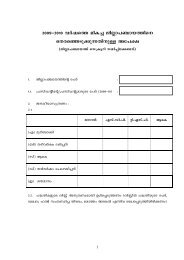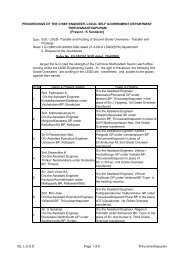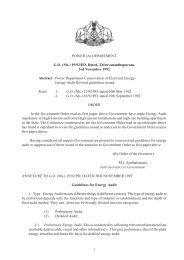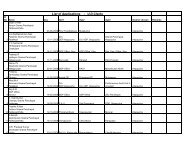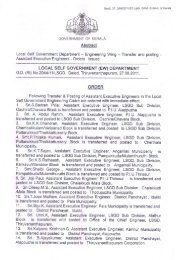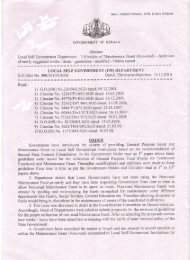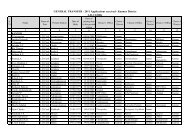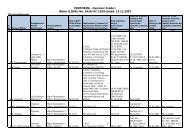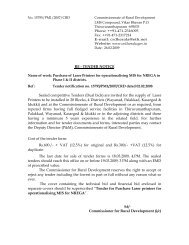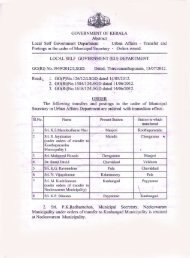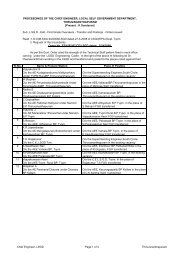Chapter 1 - Kerala Govt Logo
Chapter 1 - Kerala Govt Logo
Chapter 1 - Kerala Govt Logo
- No tags were found...
Create successful ePaper yourself
Turn your PDF publications into a flip-book with our unique Google optimized e-Paper software.
Performance February 2011SafetyRECORDABLE INJURIESCumulative Through February 20112015105015.5ImprovementTargetEnvironmental16.8ActualYear to date (YTD) progress toward achievingour environmental performance goals underthe Maine DEP STEP UP and other environmentalprograms is displayed as follows:Equal to or better than YTD goalAbove YTD goal; improvedfrom prior yearAbove YTD goal; not improvedfrom prior yearLOST-TIME INJURIESCumulative Through February 201110864204.3ImprovementTarget3.5ActualCumulative Through February 2011Solid WasteHazardous WasteEnergy CostsRecycling RateBIW NEWSBIW NEWS is published monthly by theCommunications Department (D53) ofBath Iron Works and is produced internallyin the BIW Print Shop.The primary objectives of BIW NEWSare to recognize the service, accomplishments,innovation and contributionsof our employees and to provide informationon matters that are of interest toour workforce.Comments and suggestions arewelcome and should be forwarded toDixie Stedman at Mail Stop 1210 orby e-mail at dixie.stedman@biw.com.Facility/ShiftInformation Call LineToll free information on facility status,work shift delays, and cancellations1-866-630-BATH(1-866-630-2284)Feedback from CNO Shipyard VisitSenator Collins and ADM Rougheadat BIW in February 2011.In February, Senator Susan Collins invited the Chiefof Naval Operations, ADM Gary Roughead,USN,to visit BIW to reinforce the importance of DDG 51and DDG 1000 class ships to the Navy as well as thevalue of BIW to the shipbuilding industrial base.Senator Collins shared the note which she receivedfrom ADM Roughead following the visit. ADMRoughead said, “It was so good to return, and I reallyappreciated being able to visit Bath Iron Works withyou. I always come away impressed with what I see.As I mentioned in the press conference, what I sawwas quality, innovation and pride.”ADM Roughead continued, “Again thank you forbeing there, and for your unequaled support of ourNavy, the men and women who serve, and thenation’s shipbuilding industrial base.”BIW NEWS | March 2011 | 3
4Environmental Assessment Report<strong>Kerala</strong> Local Government Strengthening Projectcontinuing role to the people. Simultaneously the Committee on Decentralization of Powersunder the late Dr. S. B. Sen, laid down clear and coherent first principles and recommendedbasic restructuring of laws of local government. These recommendations were incorporatedinto the <strong>Kerala</strong> Panchayat Raj Act in February 1999, providing the legal foundation for healthyand accountable institutions, the local governments.1.1.1 Features of Panchayati Raj in <strong>Kerala</strong>There are certain peculiar Socio-political features with respect to the Panchayati Raj in<strong>Kerala</strong>.‣ Large size of the Grama Panchayats (999 Nos) providing the natural “right size” for severaldevelopment services, especially viable service areas for PHCs, Veterinary Hospitals, KrishiBhavans and so on.‣ Large size limiting the direct participation by people only at the ward level, i.e., theconstituency of a Grama Panchayat Member.‣ Difficulty of earmarking exclusive functions for Block Panchayats (152 Nos.) which theyalone can perform better than others due to the large Grama Panchayats and relativelycompact Districts (14 Nos).‣ Rural-urban continuum, existing in the settlement pattern in <strong>Kerala</strong>.‣ Influence of the political milieu, leading to elections on party basis and polarization in thepolitical composition of local governments. This had led to the policy decision to treat PRIsas non-hierarchical, i.e., the District Panchayat has no control over Block or VillagePanchayats.Decentralization in <strong>Kerala</strong> is marked by a rare clarity of vision about the nature of localgovernments and the process of empowering them. This vision is best captured in the words ofthe Committee on Decentralization of Powers:“Local Self-Government (LSG) is essentially the empowerment of the people by giving themnot only the voice, but the power of choice as well in order to shape the development whichthey feel is appropriate to their situation. It implies maximum decentralization of powers toenable the elected bodies to function as autonomous units with adequate power, authority andresources to discharge the basic responsibility of bringing about "economic development andsocial justice". It is not enough to formally transfer powers and responsibilities to the LocalSelf Government Institutions (LSGIs). They have to be vested with the authority to exercisethem fully, which requires concordant changes not only in the appropriate rules, manuals,government orders and circulars governing development administration, but also in theconventions, practices and even, the value premises of the governmental agencies. Decentralizationdoes not mean just de-concentration where a subordinate is allowed to act onbehalf of the superior without any real transfer of authority, or delegation where powers areformally conferred on a subordinate without any real transfer or authority. It impliesdevolution where real power and authority are transferred to enable autonomous functioningwith the defined areas.
<strong>Chapter</strong> 1Introduction51.1.2 Empowering of Local GovernmentsThe transfer of functions and powers to the LSGIs and their exercise by them are governed bythe following basic principles:i. Autonomy, basically functional, financial and administrative autonomyii. Subsidiarity, transferring functions and powers from the level of the Grama Sabhas andWards Committees and go to the higher level up to the Union Government.iii. Role clarity, calling for clear perception of role in the developmental process withunity of vision and diversity of means.iv. Complimentarity, related to the principle of role-clarity, consistent with local needsand priorities and convergence into an integrated local plan.v. Uniformity, implying the norms and criteria for selection of beneficiaries and sites orprioritization of activities and pattern of assistance within a given LSGIvi. People's participation, involving the people fully by empowering them to take their owndecisions after analyzing the situation.vii. Accountability, to the people within their jurisdiction and in certain respects, to thewhole nation to be ensured through social audit of the performance of the LSGIs andobjective audit both concurrent and post-facto.viii. Transparency, ensuring decisions based on norms and criteria evolved on the basis ofsocial consensus and rationale of the decision1.1.3 Objectives of DecentralisationThe following objectives are for decentralization in <strong>Kerala</strong>.1. To improve the quality of investment by allocating resources for priorities fixed by thelocal people.2. To facilitate emergence of local solutions to developmental problems through improvedplanning, better implementation, use of traditional knowledge and appropriate technology.3. To exploit local production possibilities.4. To enable people's participation leading to better vigil in execution of schemes followed upwith better upkeep of assets.5. To provide the enabling environment for people to make contributions in kind and cash fordevelopment programmes identified by them for priority action.6. To bring about a convergence of resources and services to tackle development problemswith greater vigour.7. To unleash public action resulting in a demand led improvement in the delivery ofdevelopmental and welfare services.1.1.4 Institutions of Local GovernmentThe <strong>Kerala</strong> Panchayat Raj Act particularly through the amendments brought about in 1999 hasseveral innovative features laying a strong legal foundation for building up strong local selfgovernment institutions. The salient features are described below:‣ Grama Sabha, equated with the electoral constituency of a Village Panchayat Member, asall the electors of the Ward are members of the Grama Sabha.Suchitwa Mission, Thiruvananthapuram
6Environmental Assessment Report<strong>Kerala</strong> Local Government Strengthening Project‣ Standing Committee System, every elected Member of the Local Government gets a chanceto function in one Standing Committee or the other.‣ Control by Government, limiting to general guidelines and intervention only through aprocess and in consultation with the Ombudsman or Appellate Tribunal‣ Setting up of independent institutions, to reduce governmental control and foster theconcept of self government such asThe State Election Commission.The Finance Commission.Ombudsman for Local GovernmentsAppellate TribunalsAudit Commission State Development CouncilThe powers and responsibilities of the Grama Sabha as defined in the Act are given in AnnexureII.1.1.5 Decentralised planning ProcessThe decentralised local level planning has been used as the engine for harnessing public actionin favour of decentralisation. In order to shake the system and force the process, a campaignapproach has been followed. This campaign has succeeded in setting the agenda fordecentralised development. The salient features of the campaign methodology are describedin Annexure III, stage by stage.1.1.6 Finances of PRIsThe first State Finance Commission, constituted in May 1994, analysed the resourcemobilisation aspect in local governments and suggested fundamental changes to ensurerationalisation and control tax evasion. Though the Finance Commission recommended one percent of the net revenue of the State to be devolved to local governments, the Governmentwent far beyond and decided to devolve 35 to 40% of the Plan Funds to local governmentsOnly the Grama Panchayats and Municipalities are given the power of taxation. Theestablishment cost of Block and District Panchayats are met by a non-plan grant-in-aid fromGovernment. The major taxes levied by Village Panchayats are Property Tax, Profession Tax,Entertainment Tax and Advertisement Tax, the last one practically not exploited. The assignedtaxes by the State Government consist of Land Revenue and Surcharge on Stamp Duty and theshared tax is the Motor Vehicle Tax. The <strong>Kerala</strong> Panchayat Raj Act provides for levy of usercharges and also availing of institutional finance by Panchayat Raj Institutions.1.1.7 Performance AssessmentDecentralization has had several positive spin-offs. They are summarized below:1. The formula based devolution of funds has ensured that funds have flowed to every nookand corner of the State including the hitherto outlying and backward areas, facilitatingpublic investment.
8Environmental Assessment Report<strong>Kerala</strong> Local Government Strengthening Projecto Analysis of the development sector(s)/area(s) assigned to it.o Evaluation of the performance during the last five years.o Identification of existing problems, gaps, needs, possibilities.o Generation of a shared vision on the development of the sector(s)/area(s)o Suggesting an action plan to realize the vision with priorities and reasons for thepriority.o Preparation of draft projects to implement the action plan.o Identification of spillover projects.o Updation of development reports.o Monitoring of projects every quarter.o Any other task assigned by the DPC or local government1..2 Enviirronmentt rrellatted Functtiionss and Ressponssiibiilliittiiess off LocallGoverrnmenttssConservation and protection of the environment have been an inseparable part of Indianheritage and culture. Realizing its importance, necessary amendments have been made in theIndian Constitution from time to time. The incorporation of the Part IX and IX A in theConstitution of India, made through 73rd and 74th Amendment in 1992, enabled the GramaPanchayats and Municipalities to perform functions related to environmental management.Therefore, the Grama Panchayats are assigned with functions as much as 29 subjects, in theEleventh Schedule of the Constitution. Among the 29 subjects, the following are related toenvironment management.1. Agriculture including agriculture extension.2. Land improvement, implementation of land reforms, land consolidation and soilconservation.3. Minor irrigation, water management and watershed development.6. Social forestry and farm forestry11. Drinking water15. Non-conventional energy sources23. Health and sanitation, including hospitals, primary health centers and dispensaries.Addition of part IX A through amendment in the Indian Constitution, the following subjectsrelated to environment management in the 12th schedule of the Constitution have also beenadded as functions of Municipalities.1. Urban planning including town planning2. Regulation of land-use and construction of buildings3. Water supply for domestic, industrial and commercial and solid waste management.4. Public health, sanitation conservancy and solid waste management.5. Urban forestry, protection of the environment and promotion of ecological aspects.7. Provision of urban amenities and facilities such as parks, gardens, playgrounds.9. Regulation of slaughterhouse and tanners
<strong>Chapter</strong> 1Introduction9Therefore, the Local Governments have significant role in environment management.The level of awareness regarding environmental issues is high in <strong>Kerala</strong> and therefore,Government of <strong>Kerala</strong> could undertake several programs and initiatives having linkage toenvironmental management and sustainable development. For example:The Panchayat Level Resource Mapping Programme, as a tool for environmental appraisalof resources and natural resource based planning at the village level and for realizing thegoal of spatial planning.The state wide campaign of preparing Watershed based Development Master Plan at theBlock Panchayat Level (1990, 1998), as a tool for institutionalizing decentralized planningbased on geohydrological unit.The <strong>Kerala</strong> Total Sanitation and Health Mission (1999) for coordinating sanitation campaignin the state leading to almost 97% of the villages achieving Open Defecation Free status, asuccess story of the Total Sanitation Campaign of Government of India.The Clean <strong>Kerala</strong> Mission (2003) for enabling the urban and rural local bodies to establishintegrated municipal solid waste management system.The Suchitwa (Sanitation) Mission (2003) for proving advisory support to the stategovernment and handholding support to the local governments in the form of enabler in allrespects (capacity building, project formulation, regulatory advice, top-up grant,technology provider etc) for achieving improved output in all sanitation components andsustainable outcome in the health and environmental aspects.Though many of the known functions and activities, normally undertaken by the PRIinstitutions as part of their routine business, are examined implicitly for their likely impact onenvironment, there are no concrete or physically well defined procedure for explicitassessment.1..3 Natturrall Ressourrcess Managementt and Locall GoverrnmenttssNatural Resources like land, water and biomass are fundamental factors that have a bearingon the livelihoods of the rural poor. Attempts by Local Governments to integrated naturalresource management began in the Ninth Plan with the initiative for Block level WatershedMaster Plan preparation. With the introduction of NREGA, Local Governments have embarkedupon a trajectory of community based integrated natural resource management. The focus ofthe works permitted by the Act is on development of natural resources particularly land, waterand biomass that would help in addressing drought, deforestation and soil erosion. A largemajority of NREGA workers reside in areas where protective and restorative measures areurgently needed. The complementarity of NREGA would provide the much needed fillip towatershed development programmes of Local Governments.Government of <strong>Kerala</strong> have decided that core objectives of the People’s Plan component ofEleventh Plan would be revitalization of agriculture and promotion of local economicSuchitwa Mission, Thiruvananthapuram
10Environmental Assessment Report<strong>Kerala</strong> Local Government Strengthening Projectdevelopment along with improvement of public services with focus on the poor. Themethodology aims at improving the quality of planning and preparing District Plans, withenhanced participation of the people and support of professionals. The core of the newmethodology would be preparation of integrated Watershed Management plans, following theprinciples of iterative, multilevel planning, with local watershed plans being prepared with afull understanding of the River Basin issues and being organically merged to form a River BasinManagement plan. This process will be highly participatory, involving agricultural workers,farmers, all those dependant on natural resources and farm produce for their livelihood, andofficials, professionals and activists concerned. The outputs would be implementable actionplans for increasing production and productivity in agriculture and other allied sectors. Theoutcomes are expected to be progressive restoration of water- land- biomass balance andimproved livelihood opportunities based on sustainable natural resources management. Inorder to make this happen conservation activities like afforestation, biomass development,soil and water conservation, water resource development and promotion of sustainable incomegeneration activities would have to be attempted through community based organizations,ensuring micro watershed based governance of resources.One of the objectives of decentralisation is to increase public participation in decision making.Public participation coupled with locally accountable people’s representatives will increaseefficiency and equity in the use of natural resources. Sustainable systems of natural resourcemanagement would require community participation in the planning and implementation ofnatural resource development programmes and the management of these resources. Thiswould be critical to build ownership and participation of the local community in the wholeprocess. Local Governments are ideally placed to bring about this transformation in the localdevelopment paradigm.Experience of decentralization shows that it is easier to sensitize Local Governments to thesubtle links that exist between natural resources within a natural boundary called watershed.Local Governments have greater potential than line departments to push integrated naturalresource management approach because of their effectiveness in:a) Empowering stakeholdersb) Resolving conflicting interests of stakeholdersc) Fostering adaptive management capacityd) Adopting inter-disciplinary solutions to developmental issuese) People’s participationThe Local Governments have specific role, especially in the areas of sustainable managementof resources, land use, conservation of water, waste management, health and sanitation andenvironment protection. At present the Local Governments are in general utilizing theexpertise and services available in various state <strong>Govt</strong>. agencies for the delivery of thosefunctioning. The Local Governments have been so far successful in addressing some specificareas of environment management like solid waste management, slaughter house, publichealth and sanitation including managing of hospitals, using their own resources or mobilizing
<strong>Chapter</strong> 1Introduction11external support. Only very limited service are being rendered by Local Governments in theareas of water conservation and environmental protection. Strengthening of activities in theareas of land use, agriculture and social forestry, drinking water etc. is also crucial.Local Governments can play significant role in conserving natural resources, maintaining microenvironment prevailing in the area, conservation of water bodies, rain water harvesting etc.The Local Governments can play a role by coordinating the services / activities of relevantState Government agencies and ensure a holistic approach for protection of environment. Alsothe three tier system of Local Governments can be used effectively for bringing in a regionalperspective in the planning process, especially in issues related to natural resourcemanagement and watershed management. Local Governments thus should play a moreproactive role in bringing in sectoral and regional convergence in development interventions.1..4 Enviirronmenttall Capaciitty Buiilldiing off Locall Goverrnmenttss iin Kerralla --Prreviiouss AttttempttssDemocratic decentralization and participatory planning initiated in <strong>Kerala</strong> during the last oneand a half decade has been made significant efforts to bring the issue of natural resource andenvironment management in the development politics of the state. The People’s PlanningCampaign realized the importance of natural resources and environment management forsustainable development of the state and for strengthening the primary production sectors andpromoting livelihood of the poor and the deprived sections of the society. In order to facilitatethis, massive efforts was taken for capacity building of different local governmentfunctionaries. The training programmes for local plan formulation included:Need Identification Phase (Grama Sabha)Prioritization Phase (Development Seminar)Projectization Phase (Working Groups)Plan Formulation Phase (Elected Council)Plan Appraisal Phase (Technical Advisory Group)Plan Approval Phase (District Planning Committee)Natural resource and environment management and sustainable development was one of thetopics in the generic training module on local plan formulation for all the stakeholders of localgovernance. In the designing and implementing the training module on natural resources andenvironment the support of the state level scientific, environment and training institutionslike, the Centre of Earth Science Studies ( CESS), Centre for Water Resources Developmentand Management ( CWRDM )<strong>Kerala</strong> Agriculture University ( KAU), State Institute of RuralDevelopment (SIRD) and institutions managed by NGOs like, Integrated Rural TechnologyCentre ( IRTC), Peerumedu Development Society(PDS), Malanadu Development Society ( MDS)have been utilized by the State Planning Board.As a result of the massive capacity building exercise during the People’s Plan Campaign,massive awareness to the different functionaries of local governments was created in thefollowing subject areas:Suchitwa Mission, Thiruvananthapuram
12Environmental Assessment Report<strong>Kerala</strong> Local Government Strengthening ProjectSustainable Development and Environment ManagementAgriculture Development and Enhancing Food ProductionSanitation and Solid Waste ManagementSanitation and Water ManagementWatershed Development and Strengthening Rural LivelihoodEnvironment Impact Assessment and Formulation of Development ProjectsIn order to bring in more focus on the issue of natural resources and environment managementin development planning and to engage the community in the local level planning andimplementation of local plans with implicit objective of sustainable development, newinitiatives for capacity building was made by the state Planning Board during the close of theNinth Plan period. Efforts have been made for organizing special Grama Sabhas for discussingissues related to watershed development and natural resource management. Localgovernments prepared baseline documents and discussion notes on issues related to watershedmanagement and presented in Grama Sabha meetings. Grama Sabha meetings attended bycommon people delineated micro watersheds and discussed, in detail, the issues related todepletion of natural resources and management of environment.Specific training programmes have been designed and implemented for the Block LevelWatershed Committee members and the elected representatives and officers of different linedepartments transferred to local governments. This was to develop master plan for watershedbased development by the Block Panchayats with a regional development perspective. Thecore subject areas of the training programme were:Basic concept of watershed development and natural resource managementIdentification and delineation of micro watershedsPRA Techniques for assessing the watershed development and natural resourcesmanagement issuesPreparation of Baseline report on natural resources and environmentPreparation of Watershed Status Report: Structure and MethodologyDuring the Tenth Plan period, efforts have been made for institutionalizing the capacitybuilding interventions. In order to facilitate this, appropriate manuals and guidelines havebeen prepared on various aspects of natural resources management, environmentalassessment, sanitation etc as part of the Decentralization Support Programme (DSP). Effortshave also been made by the Government of <strong>Kerala</strong> to forge linkages between scientificinstitutions and local governments for improved capacity building and handholding support.The important constraints and limitations of the capacity building efforts for natural resourcesand environment for local governments during the Ninth and Tenth Plan period are listedbelow:
<strong>Chapter</strong> 1Introduction13Lack of policy and legal framework for intervention of local government in naturalresources and environment managementCapacity gaps of elected representatives and officials of local governments was notscientifically assessed and training was not properly designedScope and importance of sustainable development was not explicitly incorporated in thetraining modulesNo separate working group at the local level for watershed development and naturalresources managementLack of comprehension on the concept and methodology of integration of differentdevelopment sectors with an overall objective of sustainable developmentLack of capacity of the plan appraisal team to assess the environmental impact of differentdevelopment projects and effective tools and techniques for doing environmentalassessmentInadequacy of appropriate Environmental Management Framework.1..5 Kerralla Locall Goverrnmentt and Serrviice Delliiverry Prrojjectt ((KLGSP)) ––an OverrviiewThe objective of this project is to enhance and strengthen the institutional capacities of localgovernments in <strong>Kerala</strong> to deliver services and undertake their basic administrative andgovernance functions effectively. Direct beneficiaries of the project will be the 978 GPs and60 Municipalities in the State of <strong>Kerala</strong>. Investments made by the GPs and Municipalities willindirectly benefit the entire population (29.5 million) of the State of <strong>Kerala</strong>.The project will have four components with an estimated cost of US$338.4 million. A briefdescription of the project components is described below.Component 1: Performance Grants. This component will phase in an annual, performancebasedgrant to all GPs and Municipalities in <strong>Kerala</strong>. The grant will be spent on both thecreation and maintenance of capital assets used in service delivery. The overall goal is toimprove GP and municipal performance in local governance and public service delivery.Allocation of this grant to the local government will be based on performance which will bedetermined through an Annual Performance Assessment exercise taken up under the project.Component 2: Capacity Building. This component will provide capacity building inputs tostrengthen and supplement the existing systems and human resource of municipalities and GPsto enhance their institutional performance. The focus will be in four core areas:(i)(ii)(iii)(iv)Development and improvement of administrative systems used by LSGs;Strengthening of capacities of LSGs personnel using these systems;Mentoring directed at human resource capacity improvement and supplementation; andStrengthening of the overall institutional capacities of the key organizations responsiblefor delivering LSG training in <strong>Kerala</strong>.Suchitwa Mission, Thiruvananthapuram
14Environmental Assessment Report<strong>Kerala</strong> Local Government Strengthening ProjectComponent 3: Enhancing State Monitoring of the Local Government System. This componentwill provide support to strengthen the system of performance monitoring of GPs andmunicipalities in <strong>Kerala</strong>. This component will comprise four sub-components:a. Establishment of a database of GP and municipal information.b. LSG Service Delivery Survey.c. Project Evaluations.d. Establishment of a Decentralization Analysis Cell (DAC).Component 4: Project Management: This component will provide support to the ProjectManagement Unit (PMU) within the LSGD in overall coordination, implementation, monitoringand evaluation of the project.1..6 Conttextt off tthe ESAThe project has been classified under category B as per World Bank norms. This mandates thepreparation of an Environmental and Social Management Framework (ESMF) as a necessaryprocedural requirement for project appraisal and adherence / compliance to the ESMF duringproject implementation, a vital performance criterion.Incidentally, the incorporation of the Part IX and IX A in the Constitution of India, madethrough 73rd and 74th Amendment in 1992, has also integrated ample provisions entrusting theGrama Panchayats and Municipalities to perform functions related to E&S management.Sustainable systems of natural resource management would require community participation inthe planning and implementation of natural resource development programmes and themanagement of these resources. Local Governments are ideally placed to bring about thistransformation in the local development paradigm. Even in this context, the ESMF will be asuitably relevant tool placed in the hands of local governments as it will empower them tomanage E&S issues arising out of their own decisions and plans.Given the inherent nature of the project goals, there are no concrete or physically welldefined interventions proposed, which could be examined or assessed for likely environmentaland social (E&S) impacts in order to develop an ESMF. However, many of the known functionsand activities normally undertaken by the PRIs as a matter of routine can be examined.The ESA and ESMF developed for this project shall have the following components:An in-depth understanding of the functioning of the local government includingfunctions, authority, roles and responsibilities at various levels.A detailed study and analysis of the existing State and Central legislation pertaining toactivities and functions assigned to local governments;
<strong>Chapter</strong> 1Introduction15An ESMF that identifies / recognizes possible E&S impacts of typical local governmentfunctions or interventions, recognizes the likely impacts and enables the users to takedecisions that appropriately mitigate the same.An Institutional Plan that specifies roles and responsibilities various players along theLSG hierarchy have to perform / bear with respect to grant of E&S approval to anyproposed LSG activity.A Capacity Building Plan that strives to build the capacity of different stakeholders tomainstream E&S compliance in their day-to-day functioning.An appropriate monitoring mechanism to track the implementation of the EMF.Suchitwa Mission, Thiruvananthapuram




